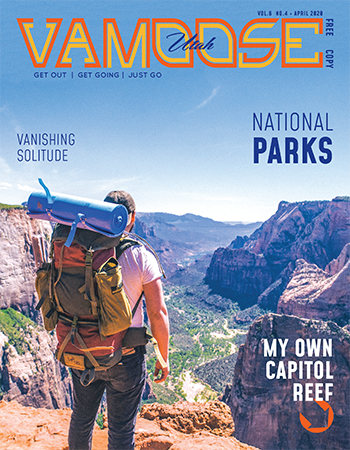Walk Utah’s longest hike:
the Highline Trail
Think of it as Utah’s Appalachian Trail. True, the Highline Trail in the High Uintas Wilderness is accessible to day hikers seeking scenery and wildlife, but it was established with the long-distance thru-hiker in mind—the ones looking to test their soles on a 100-mile (95.7 miles, to be exact) point-to-point trek.
The Uinta Mountains—the highest major mountain range in the lower 48 that runs east-to-west—are home to Utah’s highest summit, Kings Peak. From the trail’s start at Hayden Pass trailhead—the highest point on the Mirror Lake Highway (noticing a trend, yet?)—countless alpine lakes, rocky summits and snow banks must be traversed to arrive at the Highline Trail’s eastern terminus near Flaming Gorge. For most of the 95.7 miles, you’ll be traveling above the 10,000-foot mark.
With so much to see along the way, taking your time to traverse the Highline Trail is ideal. There’s a short window between snow season and mosquito season, so plan your trip accordingly. To be prepared for whatever Mother Nature throws at you, be sure to pack a fly-fishing rod, a camera, bug spray, an ice axe and loads of perseverance, among your other essentials.
This overview is intended to inform and entertain readers, but should not be used in place of a USGS map, a full guidebook and sound judgment of one’s ability level.
 Day-Hike the Highline
Day-Hike the Highline
If you’re not ready for 100 miles of continuous hiking or the logistics involved in a car shuttle, you can still take in some of the trail’s scenery on a day hike. Our favorite jaunt starts at Hayden Pass, and then runs east, then north, and through Naturalist Basin. Keep hiking, and you’ll eventually hit the lovely high-elevation Jordan Lake.
Noteworthy Points Along the First Half of the Highline Trail
As you approach Kings Peak, spend your first night at one of Packard Lake’s scenic campsites—all primitive—and get some great fishing as your first night’s reward. Wilder Lake, at 9,916 feet above sea level, is the lowest point on the trail. Anderson Pass, which you’ll walk over on your third or fourth day, sits at a nosebleed-inducing 12,700 feet above sea level, and will leave you asking, rhetorically, “Got oxygen?”
 More Noteworthy Points
More Noteworthy Points
The portion of the hike between Porcupine Pass and Tungsten Pass has some of the highest concentrations of lakes in the High Uintas. Naturally, it’s a fly-fisher’s paradise. Working in a shorter day to fish along this section of the trail is advisable—there will be long days on rugged terrain ahead.
 Kings Peak
Kings Peak
Most hikers looking to tackle the entire length of the Highline won’t miss the opportunity to top out on Kings Peak. A quick day trip off the main trail, this peak will increase your total distance to just over the century mark. Make your camp west of Yellowstone Creek—say, in the meadow about a mile before the switchbacks up the ridgeline—and get an early start to beat the afternoon thunderstorms and the crowds.
This Is the End
All good things must come to an end, and so does the Highline Trail. End the trip officially at Highway 191 outside Vernal, or Chepeta Lake for a shorter 62-mile version. Most likely, you’ll have to shuttle your car back to Hayden Pass.
Get a Steak and a Beer
When was the last time you had a burger and fries—or, hell, a bloody steak? Take your pick between Vernal Brewing Company in Vernal, Pinn Willies in Talmage, and Bear River Lodge near Coalville. Yeah, a beer sounds pretty good about now, too. You’ve earned it.
PLAN B
Visit a Lake
The Uintas are home to roughly 500 lakes, many accessible via a short (1-3 mile) hike. These lakes offer a mellow day trip. Check out Ruth Lake, which is also a popular rock-climbing destination, or Haystack Lake, where you’ll likely spot fly-fishermen casting at dusk.



